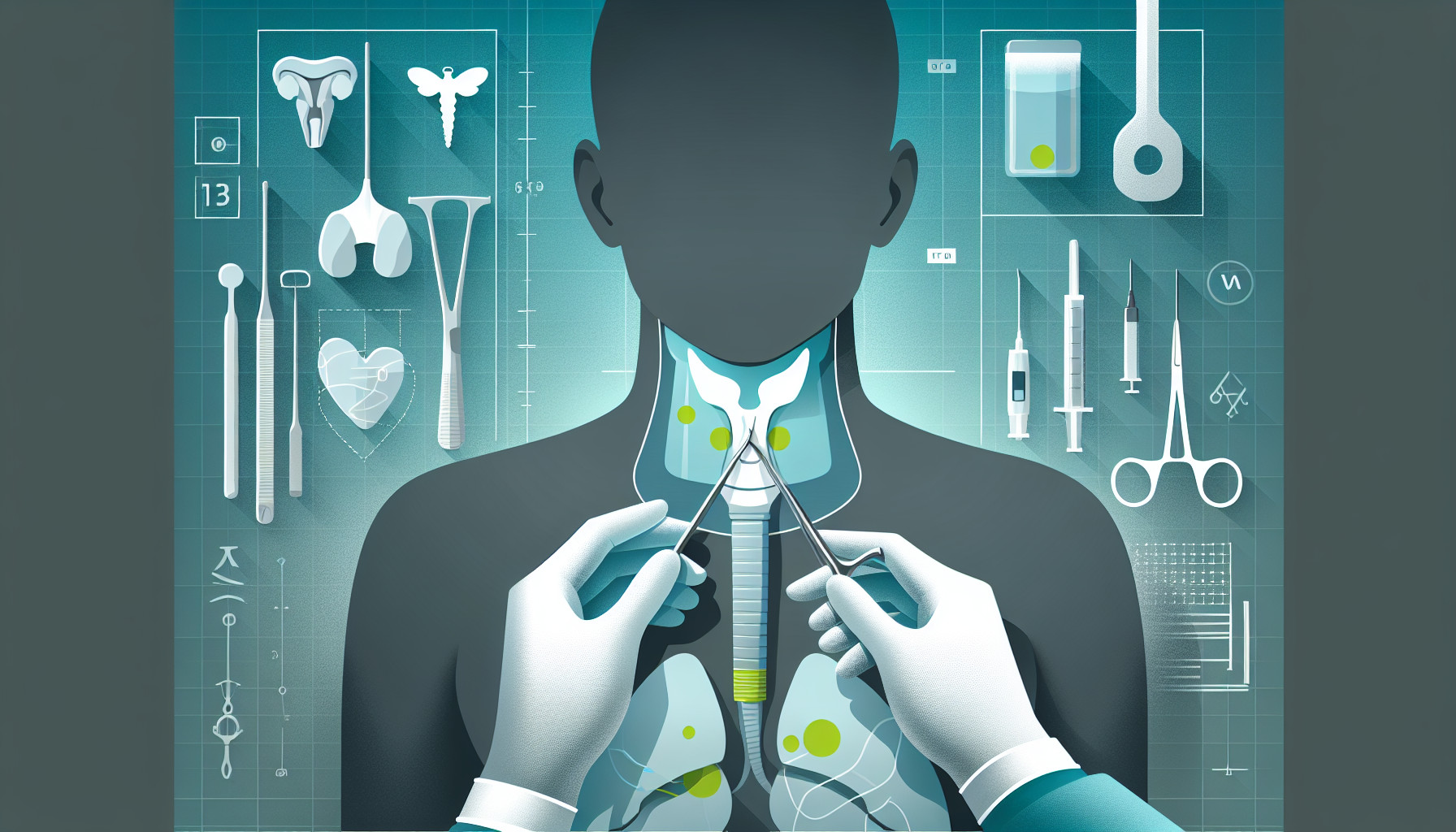Our Summary
This research paper is about a type of surgery called transoral endoscopic thyroidectomy vestibular access (TOETVA). This procedure is performed to remove the thyroid gland, which is located in the neck. Traditionally, this surgery was done by making a large cut in the neck, which would leave a scar. However, the TOETVA method is less invasive and doesn’t leave a visible scar, making it a better option for patients who are concerned about the cosmetic outcome.
The goal of this study was to review existing research on TOETVA and examine the complications associated with it. The researchers looked at six previous studies and found that the risks with TOETVA are similar to those of the traditional surgery. These can include hematoma (a swelling of clotted blood within the tissues), seroma (a pocket of clear serous fluid), injury to the recurrent laryngeal nerve, hypoparathyroidism (decreased function of the parathyroid glands), and surgical site infection.
However, they also found that TOETVA has a higher risk of thermal injury to the skin and numbness due to injury of the mental nerve. Despite these risks, the researchers concluded that TOETVA is a safe procedure for carefully chosen patients who are in good health and particularly concerned about the aesthetic outcome. As with any procedure, it’s important for patients to be informed about the potential complications before surgery.
FAQs
- What is transoral endoscopic thyroidectomy vestibular access (TOETVA) and why is it performed?
- What are the potential complications associated with TOETVA?
- How does the risk of complications with TOETVA compare to the traditional surgery method for thyroid removal?
Doctor’s Tip
One helpful tip a doctor might tell a patient about thyroidectomy is to follow post-operative care instructions carefully. This can include taking prescribed medications, keeping the incision site clean and dry, avoiding strenuous activities, and attending follow-up appointments with your healthcare provider. It’s also important to be aware of any signs of infection or complications, such as fever, excessive swelling, or difficulty breathing, and to contact your doctor immediately if you experience any of these symptoms. By following these guidelines, patients can help ensure a smooth recovery after thyroidectomy.
Suitable For
Patients who are typically recommended for thyroidectomy include those with:
Thyroid cancer: Patients with thyroid cancer may undergo a thyroidectomy to remove the cancerous cells and prevent the spread of the disease.
Benign thyroid nodules: Thyroid nodules are lumps that form in the thyroid gland and can be benign or cancerous. A thyroidectomy may be recommended for patients with large or symptomatic nodules.
Hyperthyroidism: Hyperthyroidism is a condition in which the thyroid gland produces too much thyroid hormone. In some cases, a thyroidectomy may be recommended to treat this condition.
Graves’ disease: Graves’ disease is an autoimmune disorder that causes the thyroid gland to produce excess thyroid hormone. A thyroidectomy may be recommended for patients who do not respond to other treatments.
Recurrent thyroid nodules: Some patients may have recurrent thyroid nodules that continue to grow or cause symptoms despite previous treatments. In these cases, a thyroidectomy may be recommended.
Patients with a family history of thyroid cancer or thyroid nodules: Patients with a family history of thyroid cancer or thyroid nodules may be at higher risk for developing these conditions themselves. In some cases, a thyroidectomy may be recommended as a preventive measure.
Overall, patients who are recommended for thyroidectomy are those who have a condition that cannot be effectively treated with medications or other non-surgical interventions, and for whom the benefits of surgery outweigh the potential risks.
Timeline
Before the thyroidectomy:
- Patient consults with their healthcare provider and discusses the need for thyroidectomy.
- Patient undergoes pre-operative evaluations and tests to assess their overall health and suitability for surgery.
- Patient receives instructions on how to prepare for the surgery, including fasting and medication adjustments.
- Patient undergoes the thyroidectomy procedure, either through traditional open surgery or TOETVA.
After the thyroidectomy:
- Patient is monitored closely in the recovery room for any immediate post-operative complications.
- Patient may experience pain, swelling, and discomfort at the surgical site.
- Patient is given post-operative care instructions, including wound care, pain management, and restrictions on physical activity.
- Patient may need to take thyroid hormone replacement medication for the rest of their life to regulate their thyroid function.
- Patient attends follow-up appointments with their healthcare provider to monitor their recovery and address any concerns or complications.
- Patient may experience changes in their voice, swallowing, or appearance of the neck due to the surgery.
- Patient may need to undergo additional treatments or therapies to manage any complications or side effects of the surgery.
What to Ask Your Doctor
Some questions a patient should ask their doctor about thyroidectomy, specifically TOETVA, include:
- What are the potential risks and complications associated with TOETVA compared to traditional thyroidectomy?
- How experienced are you in performing TOETVA? How many procedures have you done?
- What is the success rate of TOETVA in terms of complete removal of the thyroid gland?
- Will I need to take any special precautions or follow a specific diet or activity restrictions after the surgery?
- How long is the recovery period for TOETVA compared to traditional thyroidectomy?
- Will I need to take thyroid hormone replacement medication after the surgery?
- What kind of follow-up care will be needed after TOETVA?
- Are there any long-term effects or complications I should be aware of after TOETVA?
- How will my voice be affected after the surgery, and what can I expect in terms of hoarseness or changes in vocal quality?
- Can you explain the potential risks of thermal injury to the skin and numbness due to injury of the mental nerve, and how likely are these complications to occur?
Reference
Authors: Menderico GM Jr, Weissenberg AL, Borba CM, Sallani GM, Poy JO. Journal: Rev Col Bras Cir. 2021 Jan 20;48:e20202557. doi: 10.1590/0100-6991e-20202557. eCollection 2021. PMID: 33503138
